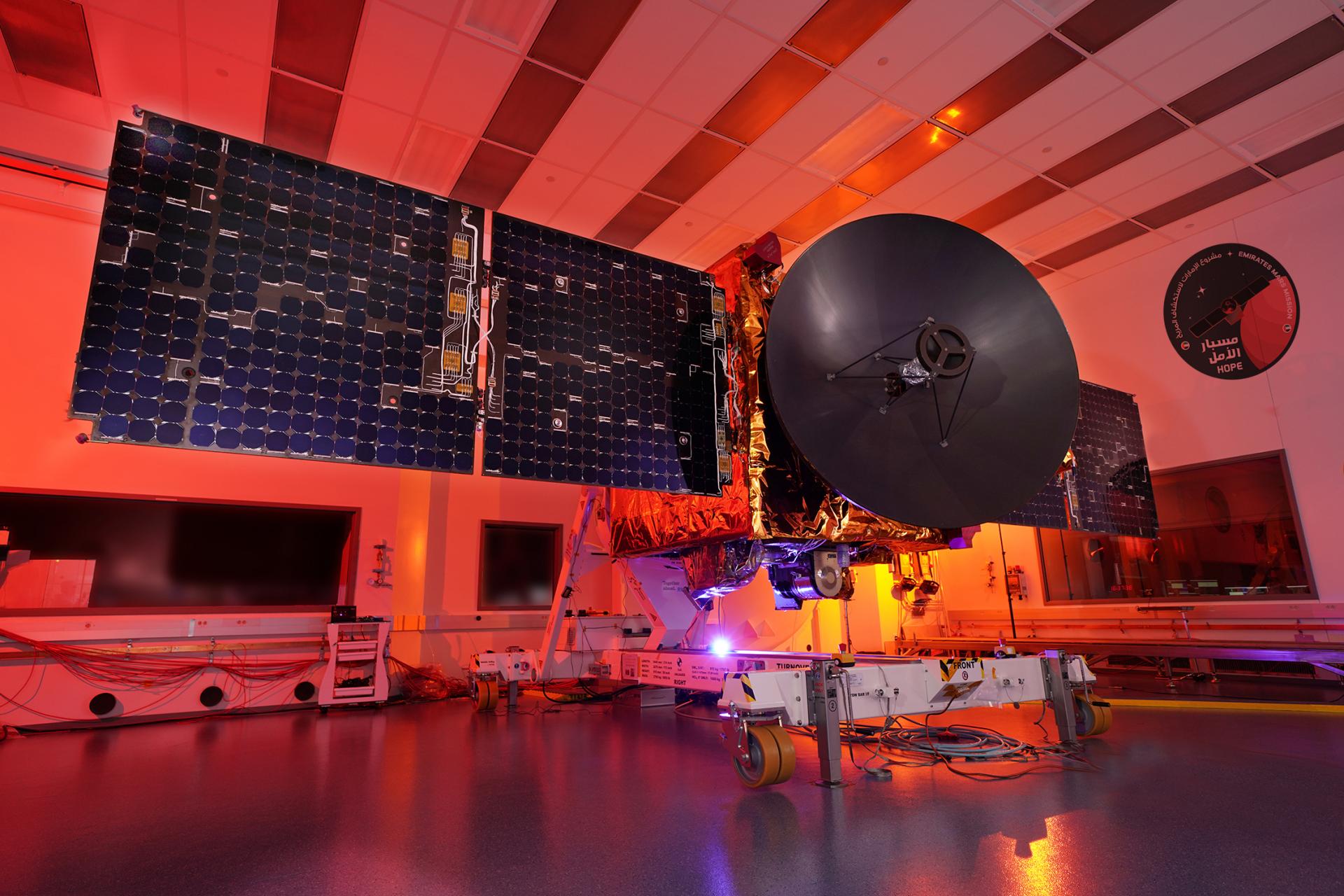The Emirates Mars Mission, also known as “Hope,” eased into orbit around the red planet on Feb. 9, sending word of its progress to operators on Earth using a novel radio provided by the Johns Hopkins Applied Physics Laboratory (APL) in Laurel, Maryland.
The first interplanetary mission built and operated by the United Arab Emirates, Hope will study the dynamics of the Martian atmosphere, aiming to build the first full picture of Mars’ climate throughout a Martian year. The probe’s trajectory through cruise to orbit insertion was tracked closely by the mission operations center at the Mohammed Bin Rashid Space Centre (MBRSC) in Dubai.
Hope is carrying the latest version of APL’s Frontier radio within its communications subsystem. The Frontier is a versatile telecommunications device proven on missions from the Sun to Pluto and beyond. As a software-defined radio — where software is used to customize the radio for specific mission requirements — the Frontier is smaller and needs less power than other deep-space radios, and can send and receive signals in a wide range of frequencies.
The radio on Hope is a duplicate of what’s flying on the APL-built Parker Solar Probe, which just completed the seventh of 24 planned, progressively closer loops around the Sun. Earlier versions have flown on the New Horizons spacecraft, now exploring the Kuiper Belt a billion miles beyond Pluto, and the Van Allen Probes, which in 2019 completed a seven-year study inside Earth’s hazardous radiation belts. Frontier radio systems are also set to fly on the Double Asteroid Redirection Test (DART), Europa Clipper, Interstellar Mapping Probe (IMAP) and Dragonfly spacecraft.

It has performed beyond expectations over Hope’s seven-month trek to Mars, starting with the first signals sent home about an hour after liftoff from Japan’s Tanegashima launch site on July 19.
“We worked with APL to specify and integrate the Frontier radio into Hope’s communications subsystem and were pleased with its performance through our reviews. We’re equally pleased with its performance throughout the mission so far,” said Khalifa Al Mheiri, telecommunications subsystem lead at MBRSC.
“We look to improve on each version,” said Philip Huang, the Hope Frontier radio systems lead in APL’s Space Exploration Sector. “We track how the system operates on each mission, and with a few design changes we make it smaller, lighter and more efficient — all very important considerations for spacecraft missions.”
APL’s Research and Exploratory Development Department (REDD) also assembled several circuit boards and electronics components. These electronic assemblies are plugged into systems such as the spacecraft flight computer, and the infrared and ultraviolet spectrometers.
The work was largely performed in REDD’s Advanced Electrical Fabrication Group, which each year builds thousands of boards, cables and assemblies for projects across APL, addressing challenges in artificial intelligence, health care, national security and space exploration.
“We’re a proud contributor to a truly international space mission,” said Allen Keeney, the group’s chief engineer. “It’s been an exciting chance to apply our skills and capabilities in a new arena.”
Hope has been a collaboration between MBRSC and several American universities, with engineers and scientists from both nations teaming up to design and build the spacecraft’s systems and three onboard science instruments. The spacecraft was constructed at the University of Colorado’s Laboratory for Atmospheric and Space Physics’ facility by a joint team of engineers from MBRSC and LASP.
The Emirates Mars Mission is the culmination of a knowledge-transfer and development effort started in 2006, which has seen Emirati engineers working with partners around the world to develop the UAE’s spacecraft design, engineering and manufacturing capabilities. The UAE is the first Arab nation to launch a mission to Mars.
“We’re honored and excited to take part in this international collaboration, and appreciate the vote of confidence in APL’s growing expertise and capabilities in spacecraft systems and communications,” said Jason Kalirai, APL’s mission area executive for Civil Space.
Follow the Emirates Mars Mission at www.emiratesmarsmission.ae.
Banner Image: Artist’s impression of the Hope spacecraft moving into orbit at Mars on Feb. 9. Hope sent word of its progress to operators on Earth using a novel radio provided by the Johns Hopkins Applied Physics Laboratory. Credit: Emirates Mars Mission
Related Topics
Science
For Media Inquiries
For all media inquiries, including permission to use images or video in our gallery, please contact:
Michael Buckley
All Media Resources

